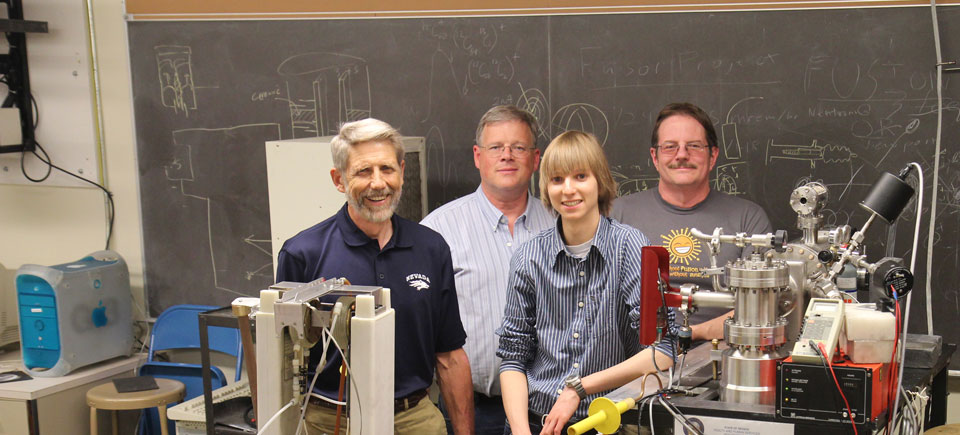When University of Nevada, Reno Foundation Professor Ron Phaneuf first met Taylor Wilson in 2008, he immediately knew the then 13-year-old Davidson Academy student was special.
"He started talking about nuclear physics," said Phaneuf, a foundation professor of physics. "I've talked to a lot of kids who are excited about science, but I could tell in Taylor's case it was very different. Even then he had a solid, fundamental understanding of the science."
On that first day, as Taylor and his father Kenneth toured Phaneuf's physics lab, Taylor talked about his goal to build a fusor to create nuclear fusion. He had already begun to accumulate materials in the family's garage for the project.
Fortunately for Taylor, he had picked the right lab and found a researcher with the right expertise. Phaneuf is a recognized leader in the field of experimental atomic and molecular physics, has led research collaborations with physicists around the globe and has received numerous awards recognizing the quality and breadth of his work. He came to the University in 1992 from the Oak Ridge National Laboratory in Tennessee, where he was research program manager and worked in the fusion program.
Phaneuf was recruited by the University to help augment a strong physics teaching program by enhancing the physics research program. He served as physics department chair for many years and led development of the University's Nevada Terawatt Facility, which houses the Z-pinch high-energy density device, the highest-power electrical device operated by any university in the United States, as well as a 50-terawatt short-pulse laser that creates temperatures in the millions of degrees to create hot, dense plasmas similar to the interiors of stars.
According to Jeff Thompson, dean of the College of Science, Phaneuf's work has fundamentally changed the science community's understanding of physical processes related to the development of energy from fusion reactors and the interpretation of observations of stars and galaxies. Phaneuf will retire from teaching in June 2012, although will continue his research funded by the Department of Energy.
Soon after his initial tour with Kenneth and Taylor, Phaneuf met with them again and offered to have Taylor work in a corner of his lab.
"I saw a sigh of relief," Phaneuf said of Kenneth's reaction. "It's best to have this project in a lab, not in a garage."
Over time and with safety as the paramount objective, other University staff members joined Phaneuf as mentors to Taylor. Now-retired Development Technician Bill Brinsmead helped Taylor acquire donated or surplus equipment from several institutions including Lawrence Livermore National Laboratory and Berkeley National Laboratory. He also helped Taylor assemble the equipment and supervised his measurements made with it. Machinists Dennis Meredith and Wade Cline assisted by machining and welding some critical components. Myung Chul Jo, the University's radiation safety officer, continues to closely monitor Taylor's work and has loaned him radiation detectors and instruments.
By the time he was 14, Taylor achieved his goal, becoming the youngest person to build a Farnsworth fusor and successfully achieve fusion. He didn't stop there.
In 2011, Taylor was a top finisher at the Intel International Science and Engineering Fair. He received one of the three Intel Foundation Young Scientist Awards for his research on innovative techniques for detecting nuclear threats, including a system that could be capable of scanning cargo containers for nuclear material. His work caught the attention of the Department of Homeland Security and Taylor was invited to present a briefing on his work to agency officials last summer.
The special kid that Phaneuf met four years ago continues to capture national attention. In February 2012, the 17-year-old was invited to participate in a science fair at the White House where he presented his project personally to President Barack Obama. A February feature in Popular Science magazine prompted more attention. CBS Evening News came to the University campus in March to visit with Taylor. He is currently preparing for the 2012 Intel International Science and Engineering Fair May 13-18 in Pittsburgh, where he has qualified to present an innovation in the realm of medicine.
Perhaps the ultimate recognition of Taylor's impact was his appearance at TED, a nonprofit initiative devoted to spreading ideas and known for the online TED Talks that have attracted millions of viewers worldwide. Taylor was invited to attend the TED2012 conference in March. Once there, TED organizers invited him to address the audience, which included celebrity-status innovators, business leaders and journalists. While other presenters may have had weeks or months to prepare, Taylor took the TED stage with only a day's notice. His presentation earned a standing ovation.
As Phaneuf said, "Taylor's excitement is contagious."
Phaneuf, who chairs the University's Radiation Safety Committee, encourages a laboratory experience that accommodates the interests of students while remaining meticulous about safety. He required Taylor to complete the University's laboratory and radiation safety training classes. Taylor's work is reported to the federal Nuclear Regulatory Commission and his fusor is registered with the State of Nevada.
Phaneuf also teaches Taylor and other students the scientific method, imparting "how one does science" from the role and importance of recordkeeping to how to interact with colleagues in the scientific community.
In return, Taylor and his font of ideas and enthusiasm have contributed to Phaneuf and others in the physics lab.
"Having a person like Taylor around gets me thinking in other directions," said Phaneuf. "He sets an inspiring example for other students."
"The satisfaction of being a teacher is to see students get excited," he said.
Taylor graduates from the Davidson Academy in May 2012 and is exploring his post-high-school options.
Opened in 2006 by Bob and Jan Davidson, the Davidson Academy of Nevada is a free public school for profoundly gifted middle and high school students, and is the only such school based on a university campus. The University's Davidson Math and Science Center is named in acknowledgement of the Davidson's financial gift toward its construction.











